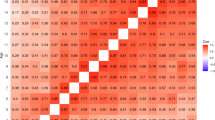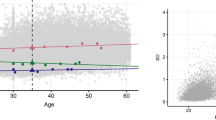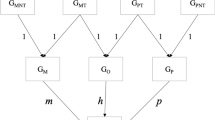Abstract
BMI increases progressively from adolescence to young adulthood. The aims of the present study were firstly, to investigate the extent to which genetic and environmental influences account for differences in BMI trajectories during this period, and secondly to examine whether boys and girls show divergences in these influences, as their BMI normally start differing across adolescence. The study sample consisted of 4,915 monozygotic and like- and unlike-sex dizygotic twins, born between 1975 and 1979. Data on BMI was gathered when twins were on average 16.1, 17.1, 18.6 and 24.4 years old. Genetic and environmental influences on the BMI trajectories were modeled using a latent growth curve approach. The results showed that the heritability of BMI decreased slightly after the adolescence period, from ≈80 to 70%. BMI transition from adolescence to young adulthood was best described by a quadratic trajectory that was highly accounted (61.7–86.5%) for by additive genetic influences. Genetic influences on BMI level showed a low correlation with those on the trend in BMI with age indicating that different sets of genes underlie the change of BMI during this period. Importantly, the analyses also evidenced that different genetic and environmental influences may underlie boys and girls evolution. In conclusion, our results suggested specific genetic influences accounting for the BMI rate-of-change from adolescence to young adulthood. This indicates that the specific genes behind BMI level may not be the same as the genes affecting BMI change which should be taken into account in further efforts to identify these genes.



Similar content being viewed by others
References
Akaike H (1987) Factor-analysis and AIC. Psychometrika 52(3):317–332
Bentler PM, Bonnet DC (1980) Significance tests and godness of fit in the analysis of covariance structures. Psychol Bull 88(3):588–606
Bodurtha JN, Mosteller M, Hewitt JK, Nance WE, Eaves LJ, Moskowitz WB, Katz S, Schieken RM (1990) Genetic analysis of anthropometric measures in 11-year-old twins: the Medical College of Virginia Twin Study. Pediatr Res 28(1):1–4
Brownson RC, Schmid TL, King AC, Eyler AA, Pratt M, Murayi T, Mayer JP, Brown DR (1998) Support for policy interventions to increase physical activity in rural Missouri. Am J Health Promot 12(4):263–266
Chambers JM, Cleveland WS, Kleiner B, Tukey P (1983) Graphical methods for data analysis. Wadsworth International Group & Brooks/Cole, Belmont
Cheung GW, Rensvold RB (2002) Evaluating goodness-of-fit indexes for testing measurement invariance. Struct Equ Model 9(2):233–255
Chou C, Yang D, Pentz MA, Hser Y (2004) Piecewise growth curve modeling approach for longitudinal prevention study. Comput Stat Data Anal 46(2):213–225
Christensen K, Frederiksen H, Vaupel JW, McGue M (2003) Age trajectories of genetic variance in physical functioning: a longitudinal study of Danish twins aged 70 years and older. Behav Genet 33(2):125–136
Cole TJ, Bellizzi MC, Flegal KM, Dietz WH (2000) Establishing a standard definition for child overweight and obesity worldwide: international survey. BMJ 320(7244):1240–1243
Cornes BK, Zhu G, Martin NG (2007) Sex differences in genetic variation in weight: a longitudinal study of body mass index in adolescent twins. Behav Genet 37(5):648–660
Duncan AE, Agrawal A, Grant JD, Bucholz KK, Madden PA, Heath AC (2009) Genetic and environmental contributions to BMI in adolescent and young adult women. Obesity (Silver Spring) 17(5):1040–1043
Evans DM, Gillespie NA, Martin NG (2002) Biometrical genetics. Biol Psychol 61(1–2):33–51
Eyler AA, Baker E, Cromer L, King AC, Brownson RC, Donatelle RJ (1998) Physical activity and minority women: a qualitative study. Health Educ Behav 25(5):640–652
Fikse WF, Rekaya R, Weigel KA (2003) Genotype × environment interaction for milk production in Guernsey cattle. J Dairy Sci 86(5):1821–1827
Gallagher D, Visser M, Sepulveda D, Pierson RN, Harris T, Heymsfield SB (1996) How useful is body mass index for comparison of body fatness across age, sex, and ethnic groups? Am J Epidemiol 143(3):228–239
Ghisletta P, McArdle JJ (2001) Latent growth curve analyses for the development of height. Struct Equat Model 8(4):531–555
Harris JR, Tambs K, Magnus P (1995) Sex-specific effects for body mass index in the new Norwegian twin panel. Genet Epidemiol 12(3):251–265
Hjelmborg JB, Fagnani C, Silventoinen K, McGue M, Korkeila M, Christensen K, Rissanen A, Kaprio J (2008) Genetic influences on growth traits of BMI: a longitudinal study of adult twins. Obesity (Silver Spring) 16(4):847–852
Jöreskog KG, Sörbom D, Scientific Software International, Uppsala universitet (1993) LISREL 8: structural equation modeling with the SIMPLIS command language. SSI, Lincolnwood
Kaprio J, Harris JR (2008) Twin studies. In: Clément K, Sørensen TIA (eds) Obesity: genomics and postgenomics. Informa Healthcare, New York
Kaprio J, Pulkkinen L, Rose RJ (2002) Genetic and environmental factors in health-related behaviors: studies on Finnish twins and twin families. Twin Res 5(5):366–371
Kimm SY, Glynn NW, Kriska AM, Barton BA, Kronsberg SS, Daniels SR, Crawford PB, Sabry ZI, Liu K (2002) Decline in physical activity in black girls and white girls during adolescence. N Engl J Med 347(10):709–715
King AC (1997) Intervention strategies and determinants of physical activity and exercise behavior in adult and older adult men and women. World Rev Nutr Diet 82:148–158
Korkeila M, Kaprio J, Rissanen A, Koshenvuo M, Sorensen TI (1998) Predictors of major weight gain in adult Finns: stress, life satisfaction and personality traits. Int J Obes Relat Metab Disord 22(10):949–957
Kuskowska-Wolk A, Karlsson P, Stolt M, Rossner S (1989) The predictive validity of body mass index based on self-reported weight and height. Int J Obes 13(4):441–453
Lajunen HR, Kaprio J, Keski-Rahkonen A, Rose RJ, Pulkkinen L, Rissanen A, Silventoinen K (2009a) Genetic and environmental effects on body mass index during adolescence: a prospective study among Finnish twins. Int J Obes (Lond) 33(5):559–567
Lajunen HR, Keski-Rahkonen A, Pulkkinen L, Rose RJ, Rissanen A, Kaprio J (2009b) Leisure activity patterns and their associations with overweight: a prospective study among adolescents. J Adolesc 32(5):1089–1103
Lammi N, Moltchanova E, Blomstedt PA, Tuomilehto J, Eriksson JG, Karvonen M (2009) Childhood BMI trajectories and the risk of developing young adult-onset diabetes. Diabetologia 52(3):408–414
Li S, Zhao JH, Luan J, Ekelund U, Luben RN, Khaw KT, Wareham NJ, Loos RJ (2010) Physical activity attenuates the genetic predisposition to obesity in 20,000 men and women from EPIC-Norfolk prospective population study. PLoS Med 7(8)
Little RJA, Rubin DB (2002) Statistical analysis with missing data. Wiley, Hoboken
Macgregor S, Cornes BK, Martin NG, Visscher PM (2006) Bias, precision and heritability of self-reported and clinically measured height in Australian twins. Hum Genet 120(4):571–580
McGue M, Christensen K (2003) The heritability of depression symptoms in elderly Danish twins: occasion-specific versus general effects. Behav Genet 33(2):83–93
Mustelin L, Silventoinen K, Pietilainen K, Rissanen A, Kaprio J (2009) Physical activity reduces the influence of genetic effects on BMI and waist circumference: a study in young adult twins. Int J Obes (Lond) 33(1):29–36
Nader PR, Bradley RH, Houts RM, McRitchie SL, O’Brien M (2008) Moderate-to-vigorous physical activity from ages 9 to 15 years. JAMA 300(3):295–305
Neale MC (1997) Mx: Statistical Modeling. Virginia Commonwealth University, Richmond
Neale MC, McArdle JJ (2000) Structured latent growth curves for twin data. Twin Res 3(3):165–177
Neale MC, Cardon LR, North Atlantic Treaty Organization, Scientific Affairs Division (1992) Methodology for genetic studies of twins and families. Kluwer, Boston
Ortega-Alonso A, Sipila S, Kujala UM, Kaprio J, Rantanen T (2009) Genetic influences on change in BMI from middle to old age: a 29-year follow-up study of twin sisters. Behav Genet 39(2):154–164
Pietilainen KH, Kaprio J, Rissanen A, Winter T, Rimpela A, Viken RJ, Rose RJ (1999) Distribution and heritability of BMI in Finnish adolescents aged 16y and 17y: a study of 4884 twins and 2509 singletons. Int J Obes Relat Metab Disord 23(2):107–115
Power C, Parsons T (2000) Nutritional and other influences in childhood as predictors of adult obesity. Proc Nutr Soc 59(2):267–272
Preacher KJ (2008) Latent growth curve modeling. SAGE, Los Angeles
Rekaya R, Weigel KA, Gianola D (2003) Bayesian estimation of parameters of a structural model for genetic covariances between milk yield in five regions of the United States. J Dairy Sci 86(5):1837–1844
Saarni SE, Silventoinen K, Rissanen A, Sarlio-Lahteenkorva S, Kaprio J (2004) Intentional weight loss and smoking in young adults. Int J Obes Relat Metab Disord 28(6):796–802
Saarni SE, Pietilainen K, Kantonen S, Rissanen A, Kaprio J (2009) Association of smoking in adolescence with abdominal obesity in adulthood: a follow-up study of 5 birth cohorts of Finnish twins. Am J Public Health 99(2):348–354
Sarna S, Kaprio J, Sistonen P, Koskenvuo M (1978) Diagnosis of twin zygosity by mailed questionnaire. Hum Hered 28(4):241–254
Schwartz G (1978) Estimating the dimension of a model. Ann Stat 6(2):461–464
Shriner D, Yi N (2009) Deviance information criterion (DIC) in Bayesian multiple QTL mapping. Comput Stat Data Anal 53(5):1850–1860
Silventoinen K, Kaprio J, Lahelma E, Koskenvuo M (2000) Relative effect of genetic and environmental factors on body height: differences across birth cohorts among Finnish men and women. Am J Public Health 90(4):627–630
Silventoinen K, Pietilainen KH, Tynelius P, Sorensen TI, Kaprio J, Rasmussen F (2007) Genetic and environmental factors in relative weight from birth to age 18: the Swedish young male twins study. Int J Obes (Lond) 31(4):615–621
Silventoinen K, Rokholm B, Kaprio J, Sorensen TI (2009) The genetic and environmental influences on childhood obesity: a systematic review of twin and adoption studies. Int J Obes (Lond) 34:29–40
Sobal J, Stunkard AJ (1989) Socioeconomic status and obesity: a review of the literature. Psychol Bull 105(2):260–275
Spiegelhalter DJ, Best NG, Carlin BP, van der Linde A (2002) Bayesian measures of model complexity and fit. J R Stat Soc B 64(4):583–616
Stunkard AJ, Harris JR, Pedersen NL, McClearn GE (1990) The body-mass index of twins who have been reared apart. N Engl J Med 322(21):1483–1487
Ventura AK, Loken E, Birch LL (2009) Developmental trajectories of girls’ BMI across childhood and adolescence. Obesity (Silver Spring) 17:2067–2074
Williams RL (2000) A note on robust variance estimation for cluster-correlated data. Biometrics 56(2):645–646
Acknowledgments
This study was supported by the Academy of Finland—Centre of Excellence in Complex Disease Genetics. The data collection of the FinnTwin16 sample was supported by research grants from the National Institute on Alcohol Abuse and Alcoholism to Dr. Richard J Rose (AA-08315, AA-00145), and from the Academy of Finland to JK (100499; 205585). KHP was supported by grants from the Helsinki University Central Hospital, Jalmari and Rauha Ahokas, Yrjö Jahnsson, Novo Nordisk and Biomedicum Helsinki Foundations. The authors declare no conflict of interests in this study.
Author information
Authors and Affiliations
Corresponding author
Additional information
Edited by Hermine Maes
Rights and permissions
About this article
Cite this article
Ortega-Alonso, A., Pietiläinen, K.H., Silventoinen, K. et al. Genetic and Environmental Factors Influencing BMI Development from Adolescence to Young Adulthood. Behav Genet 42, 73–85 (2012). https://doi.org/10.1007/s10519-011-9492-z
Received:
Accepted:
Published:
Issue Date:
DOI: https://doi.org/10.1007/s10519-011-9492-z




